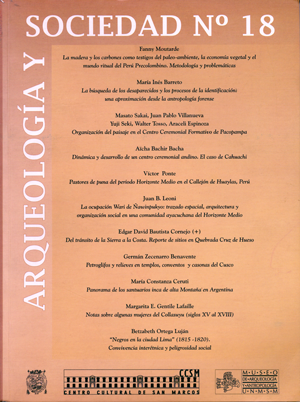Shepherds of Puna from the Middle Horizon Period in the Callejón de Huaylas, Peru
DOI:
https://doi.org/10.15381/arqueolsoc.2007n18.e13153Keywords:
Pastoralum, Middle Horizon, ceramics, textiles, Recuay, radiocarbon dates.Abstract
Archaeological data obtained from three sites located on the Pierina mining influence area, Callejón Huaylas, Perú have gathered evidence to argue for pastoralism operations during the Middle Horizon period (650 950 AD). This epoch saw a rise of llama herds. The temporal occupation has been confirmed by radiocarbon measurements that are agreed with ceramic and lithic local styles. It is suggest a possible increment on the consumption of textile by Wari State, which propelled rural centers such as Ancosh Punta. Regional interaction is assumed by the Wari control of obsidian sources, the only imported raw material for manufacturing lithic tools. Obsidian found in Pierina was obtained from Ayacucho (Quizpisisa source) and Arequipa (Alca source). However, local patterns remain the same specially in the manufacture of ceramic vessels, projectile points, and the building of rectangular funerary chullpa construction with offerings were composed of symbolic elements that reflect Wari interaction.Downloads
Published
Issue
Section
License
Copyright (c) 2007 Víctor Ponte

This work is licensed under a Creative Commons Attribution-NonCommercial-ShareAlike 4.0 International License.
THE AUTHORS RETAIN THEIR RIGHTS:
a. The authors retain their trademark and patent rights, and also on any process or procedure described in the article.
b. The authors retain the right to share, copy, distribute, perform and publicly communicate the article published in the Arqueología y Sociedad (for example, place it in an institutional repository or publish it in a book), with an acknowledgment of its initial publication in the Arqueología y Sociedad.
c. The authors retain the right to make a subsequent publication of their work, to use the article or any part of it (for example: a compilation of their works, notes for conferences, thesis, or for a book), provided that they indicate the source. of publication (authors of the work, journal, volume, number and date).






